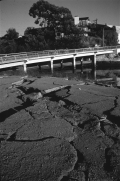2006, 346 pp.
 Cracks in the San Lorenzo River Levee, near Jesse Street, Santa Cruz. Photo by Jeff MarshallOn October 17, 1989 at 5:04 p.m. a 6.9 magnitude earthquake on the San Andreas Fault shook the Central Coast of California and lasted for fifteen seconds. The epicenter of the quake lay near Loma Prieta Peak in the Santa Cruz Mountains, about ten miles northeast of the city of Santa Cruz, deep in the redwoods of Forest of Nisene Marks State Park. The focus point was at a depth of ten miles. This earthquake killed sixty-three people and injured 3,757 others, and caused an estimated six billion dollars in property damage. It was the largest earthquake to occur on the San Andreas fault since the great San Francisco earthquake in April 1906.
Cracks in the San Lorenzo River Levee, near Jesse Street, Santa Cruz. Photo by Jeff MarshallOn October 17, 1989 at 5:04 p.m. a 6.9 magnitude earthquake on the San Andreas Fault shook the Central Coast of California and lasted for fifteen seconds. The epicenter of the quake lay near Loma Prieta Peak in the Santa Cruz Mountains, about ten miles northeast of the city of Santa Cruz, deep in the redwoods of Forest of Nisene Marks State Park. The focus point was at a depth of ten miles. This earthquake killed sixty-three people and injured 3,757 others, and caused an estimated six billion dollars in property damage. It was the largest earthquake to occur on the San Andreas fault since the great San Francisco earthquake in April 1906.
While the national media covered the damage in the San Francisco Bay Area extensively, far less attention was paid to the effects of the earthquake in Santa Cruz County, where the earthquake was actually centered. In the city of Santa Cruz much of the downtown Pacific Garden Mall, composed of older brick structures located on unconsolidated river sediments, collapsed, killing three people and injuring others. Ten miles to the south in Watsonville, a largely Spanish-speaking city, buildings also crumbled and people were killed. In the Santa Cruz Mountains, landslides closed many roads including Highway 17, which traverses the rugged mountains between Santa Cruz and San Jose, and for several days traffic was allowed through only in escorted convoys.
In the spring quarter of 1990 the Regional History Project sponsored a student internship class entitled, "An Interdisciplinary Oral History of the October 17, 1989 Loma Prieta Earthquake". Randall Jarrell, who was the project's director for many years, was the instructor for the class, which was co-sponsored with UCSC faculty members John Dizikes in history and Conn Hallinan in journalism. Five students signed up for the course. They completed eleven oral history interviews.
One of the interviews is with Barbara Garcia, who was director of Salud Para La Gente, a bilingual primary health care facility serving the greater Watsonville area. In the immediate aftermath of the earthquake, this community organization stepped in to address the enormous problems created by the lack of bilingual/bicultural volunteers from the Federal Emergency Management Agency and the Red Cross. Diane Chang-Wilson interviewed eleven members of a fifth grade class at Rio del Mar School in Aptos. Chang-Wilson's oral histories provide candid reflections from children on how they felt and experienced the earthquake. Other interviews include Quinton Skinner, who was a UCSC student and an employee at Universes Records on the Pacific Garden Mall at the time of the quake; seventy-two year old Mayme Metcalf, who managed a small apartment complex in the Beach Flats area of Santa Cruz; Ramona Noriega, a UCSC re-entry student and mother of four children; and several narrators who had committed to a program of recovery from addiction to alcohol or other drugs when the earthquake happened. These oral histories illuminate the diverse subjectivity of this historical event in ways that are not captured in news photos and articles, and geological or engineering reports on structural damage.


 Santa Cruz, CA
Santa Cruz, CA



